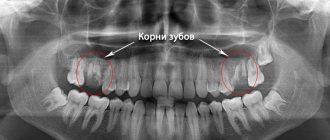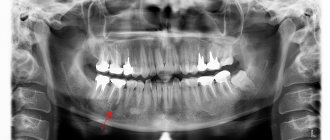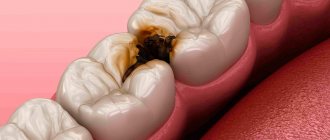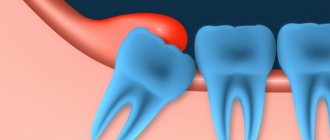Indications for permanent tooth extraction
Routine removal is carried out for those patients who have been diagnosed with congenital or acquired pathologies as a result of injuries and poor hygiene:
- obstruction of root canals;
- fracture of the crown exposing the pulp or root;
- mobility caused by acute periodontitis;
- abnormal position, preventing normal chewing of food, causing injury to the oral mucosa, speech defect;
- jaw tumors.
Sometimes extraction of a molar is necessary during orthodontic treatment.
If a patient goes to the dentist with severe pain, and upon examination it turns out that the treatment will not bring the desired effect, then removal is carried out urgently.
X-ray of a molar to be removed
Root apex resection: patient reviews
All patients note that the operation is absolutely painless. However, postoperative pain will occur immediately after anesthesia (severe pain after resection is not typical). The next morning you may see swelling of the soft tissues of the face in the projection of the operation, sometimes a hematoma. In rare cases, suppuration of the surgical wound occurs, but this does not happen often. Prophylactic antibiotics help prevent this complication.
After surgery, they are usually prescribed -
- antibiotic Amoxiclav 625 mg (1 tablet – 2 times a day, 6-7 days),
- NSAID-based analgesics,
- rinsing with a solution of 0.05% Chlorhexidine.
Relapse and reoperation - the percentage of relapses according to official statistics is about 1-3%. If the operation is performed according to all the rules, then there should be no complications. There are 2 main points that determine the quality of the operation. Firstly, the cyst shell must be completely removed (since even a small fragment of the cyst shell remains, it will appear again).
Secondly, this is the quality of root canal filling. If the root canal was poorly prepared, for example, it was not sealed tightly, this will lead to the spread of infection along the canal walls and a new cyst formation. And retrograde root canal filling, which we described above, can also help here.
Features of the procedure
Inspection alone is not enough to remove a molar. So that the doctor can see the location of the roots, it is necessary to take an x-ray.
The tactics of the operation are selected depending on the data received:
- if the picture is favorable, the molar is removed with special forceps, which are selected according to the anatomical shape and location of the crown (for the upper or lower jaw, right and left);
- in difficult situations (atypical location, the presence of mucous and bone tissues hiding the crown, the soft structure of the molar, the location of the root deep in the socket), a surgical method is used that involves dissecting the tissues and bones of the jaw.
If removal cannot be carried out only with forceps, then an elevator is used - a tool that reduces the trauma to mucous tissues when extracting single roots.
How is the operation performed?
Before removal, the dentist examines the patient’s oral cavity and takes an x-ray. After diagnosis, he selects a surgical procedure and explains to the patient why it is necessary to remove the wisdom tooth. Removal can be simple or complex. The second operation is more difficult, as the gums and bones are affected.
Easy removal
It is carried out in the same way as on ordinary teeth. Suitable for removal of the upper eights if there are no serious developmental abnormalities or complications. The dental unit is removed with forceps, without the use of other instruments. The operation is low-traumatic and takes from 10 to 30 minutes.
Step-by-step removal of the 8th tooth:
- anesthesia;
- extraction from the hole;
- removal of fragments if the tooth is crumbled;
- treating the wound with an anesthetic.
After the operation, the doctor gives the patient recommendations for oral care over the next few days. If necessary, prescribes medications for pain and to prevent wound infection.
Difficult removal
It is carried out on the lower molars or on the upper ones, if the coronal part is practically destroyed, there are pathologies in the roots, in case of developmental anomalies, complications. The surgeon can use a scalpel, drill and other surgical instruments. Before the procedure, the patient must tell the doctor about the presence of diseases or allergies to medications to exclude contraindications. How long it takes to remove a wisdom tooth depends on the clinical picture. The duration of surgical procedures is from half an hour to two hours.
Operation stages:
- pain relief with local anesthetics;
- antiseptic surface treatment;
- cutting and detachment of a flap of gingival tissue;
- drilling the bone, extracting a dental unit;
- treatment of the wound with drugs;
- suturing.
After the procedure, the surgeon advises the patient about precautions during the postoperative period and prescribes antibacterial and painkillers. It is necessary to visit the doctor again to examine the wound.
General anesthesia or local anesthesia?
In most cases, molar extraction can be performed under local anesthesia.
An operation under general anesthesia gives the doctor more time and freedom to remove several roots at once and carry out other surgical and orthodontic measures.
Not every clinic offers this type of pain relief; in addition, the method is not recommended for people with allergic and cardiovascular diseases.
Local anesthesia before molar extraction
Alternatives to tooth resection –
Resection in most cases is not mandatory and is the only method of treating granulomas and cysts.
Mandatory resection is required only in the presence of large cysts (for example, 1.5-2 cm or more). The latter is due to the fact that the shell of large cysts is very dense and thick, and does not completely disappear even with good conservative treatment (although the cyst itself decreases in size). Therapeutic treatment of cysts is carried out by a dentist, and the only drawback of this method is the duration of therapy and a slightly larger number of visits to the doctor. In order for the granuloma/cyst to begin to shrink and disappear, it is necessary to completely neutralize the source of infection in the root canals, and then seal the root canals with a medicinal paste based on calcium hydroxide for a period of several months.
After a few months, the doctor will take an x-ray of you to see how much the cyst has shrunk, and if everything is fine, he will prescribe you for permanent root canal filling. Until this moment, you will walk with a temporary filling. It should be noted that conservative treatment is not always effective, and the tooth becomes inflamed over and over again. Therefore, it is sometimes easier to immediately fill the root canal on a permanent basis, and the next day carry out an operation to remove the cyst.
Removal of third molars
Removal of wisdom teeth (third molars) is indicated in case of their abnormal development, lack of free space on the jaw, or incipient inflammatory processes. There is a story that movie stars remove figure eights to correct their cheekbones, but professional dentists are unlikely to agree with it.
The complex structure of the “eight” (they can have from two to five roots), as a rule, an atypical formation, causes inflammatory and orthodontic relapses, so surgical intervention is usually the only correct treatment tactic.
The operation is performed using S-shaped forceps; complex molars are removed in stages:
- Gum cutting.
- Sawing the crown into several parts.
- Sequential extraction.
- Stitching of damaged tissues.
Third Molar Extraction Forceps
Tooth resection: advantages
We have already said that tooth root resection is usually done in the presence of cysts and granulomas, the occurrence of which is associated with infection in the root canal. If the root canals in the causative tooth have not previously been filled, then in most cases therapeutic treatment is first applied.
But in most cases, granulomas/cysts arise as a result of poor-quality filling of root canals (Fig. 12). Often in such situations, it is possible to immediately carry out a resection - without re-treating the canals in the tooth, but a prerequisite for this is that the root canal must be poorly sealed only at the very apex of the root, and well throughout the rest of the length.
Situations when resection is better than conservative treatment -
- There is a pin or stump inlay in the root canal (Fig. 13-14) - metal pins and stump inlays are fixed in the root canals with special very strong dental cement. An attempt to extract in this case can lead, among other things, to a fracture of the tooth root (and the need for tooth extraction).
Therefore, if there is a pin or stump inlay in the root canal, and the canal itself is well sealed throughout, and only underfilled at the root apex, then this is also an indication for tooth root resection. - When there is a crown on the tooth (Fig. 13-14) - if there is a crown on the tooth, then in order to begin conservative treatment, this crown must be removed, then the root canals must be unfilled, etc.
At the end of treatment, you cannot simply put on the old crown - you need to make a new one, which significantly increases the cost of treatment. Therefore, if there is a crown on the tooth (especially if with a pin) - as in Fig. 13-14, and the root canals are poorly sealed only at the very apex of the root, then it is better to perform a resection of the root apex. During the operation, the unfilled part of the canal, together with the apex of the root, is cut off with a drill, and the cyst is removed. We hope that our article was useful to you!
Sources:
1. Higher prof. the author’s education in surgical dentistry, 2. Based on personal experience as a dental surgeon, 3. National Library of Medicine (USA), 4. “Outpatient surgical dentistry” (Bezrukov V.), 5. “Surgical dentistry and maxillofacial surgery "(Kulakov A.).
Removal of molars in children
Children's molars appear twice - first baby teeth, then permanent teeth. It is believed that “milk jugs” can be removed without fear or regret, but this is not entirely true.
The process of formation of permanent molars is genetically determined, so it is undesirable to disrupt it. Premature removal of milk “roots” can provoke pathologies in the development of permanent ones. Incorrect bite, crooked teeth, atypical crown shapes are the result of early extraction of baby teeth.
As for permanent molars, for children they are no less important than milk teeth. It is recommended to remove them only in exceptional cases (fractures and dislocations), as they are highly treatable.
Difference between simple and complex type
- Simple baby tooth extraction can be performed without anesthesia. Removal of the complex must be carried out after anesthesia.
- Duration. The simple procedure usually lasts from five to fifteen minutes. A complex surgical intervention can last from twenty minutes to an hour, and sometimes even take place in more than one stage.
- A simple tooth is removed with forceps and an elevator. The complex procedure requires special tools that may be needed to cut, lift the tooth, or saw through the root.
- After complex surgery, you may need to take antibiotics and anti-inflammatory drugs.
Contraindications for removal
If surgery to remove a molar needs to be performed urgently, then it is not possible to take into account contraindications.
There are a number of restrictions for carrying out a planned operation:
- diseases of the heart, blood, nervous system;
- infections of the mouth and gums;
- the first and last months of pregnancy;
- period of menstruation.
Wisdom teeth do not erupt
You should contact the dentist even if the molar does not cause discomfort. It can remain in this state for up to a certain time, since dental roots grow quickly, and over time they will interfere with the neighbor’s teeth. If a tooth remains in the gum for a long time, then it is a serious provocateur of caries and decay. This arrangement of the rudiment causes injury to soft tissues, resulting in periodontitis, periodontal disease and other unpleasant diseases.
Consequences and complications
Complications may arise during the operation:
- when a crown or root splits, there is a danger of soft tissue injury, and unremoved fragments provoke inflammation;
- there is a risk of damage to the jaw nerves and bones.
Such “disasters” do not happen to doctors who have experience and qualifications. You need to remember this and not trust such a complex operation to a random specialist.
Swelling of tissues and dry socket (when a blood clot at the site of an extracted tooth accidentally breaks off or does not form at all) most often occurs due to the fault of the patient who does not perform postoperative hygiene correctly, or due to the individual characteristics of the body (lowered immunity, poor blood clotting).
It is advisable to immediately insert an artificial prosthesis or implant in place of the lost crown, since a “gap” in the dentition entails serious consequences:
- deformation and change in inclination of adjacent molars;
- increased wearability of crowns;
- deterioration of the gastrointestinal tract;
- the occurrence of a cosmetic defect (rapid aging of the skin, sagging cheeks).
Measures after removal of a molar
- If after eight hours the bleeding has not stopped, you need to press down firmly on the tampon for about half an hour.
- Rinse your mouth only after 24 hours after surgery, use a solution of warm water (one glass) and table salt (one teaspoon).
- After eating, rinse your mouth with infusions of chamomile, sage or calendula (take into your mouth, hold for a few minutes and spit).
- If the pain does not go away after removal and the bleeding does not stop, then you need to visit the doctor again.
Is it painful to remove a wisdom tooth?
This is not to say that during such manipulation there will be no sensation of pain. Initially, local anesthesia is administered, but the patient will still feel discomfort and mild pain. Why? The wisdom tooth has a root system that is distinguished by its power. And when it is removed, not very pleasant sensations arise.
Don't use too much painkiller. After the anesthesia wears off, you will feel unwell and in pain. These sensations will continue for several more days. The discomfort will disappear after the stitches heal.











